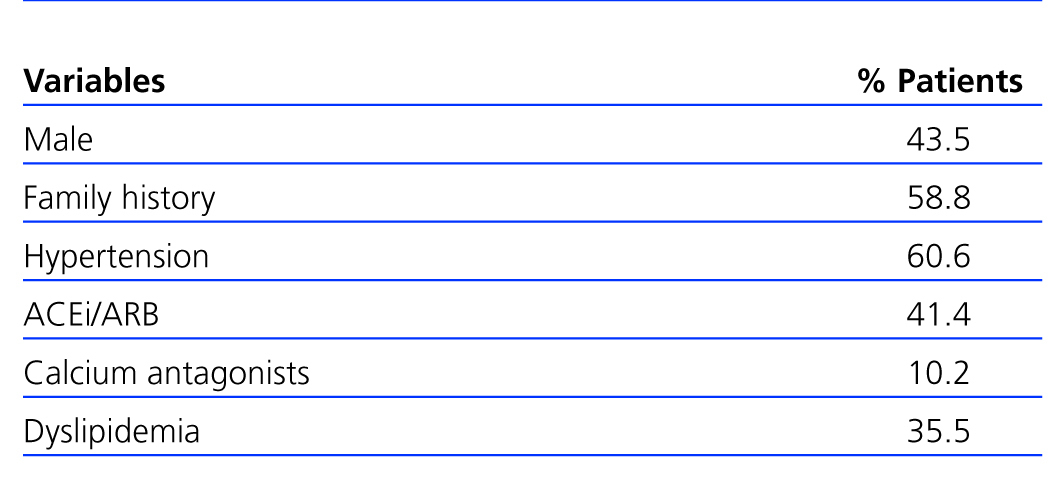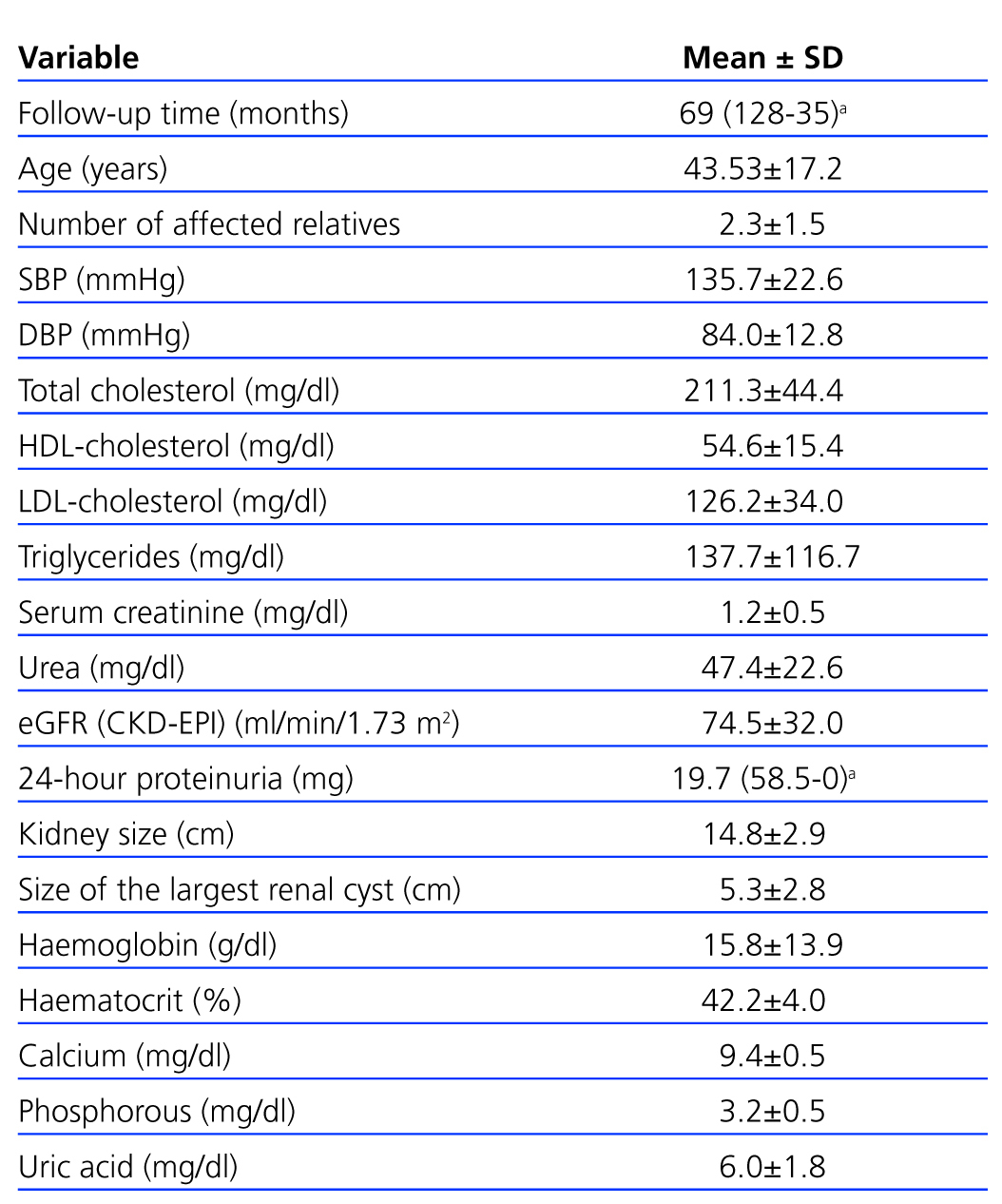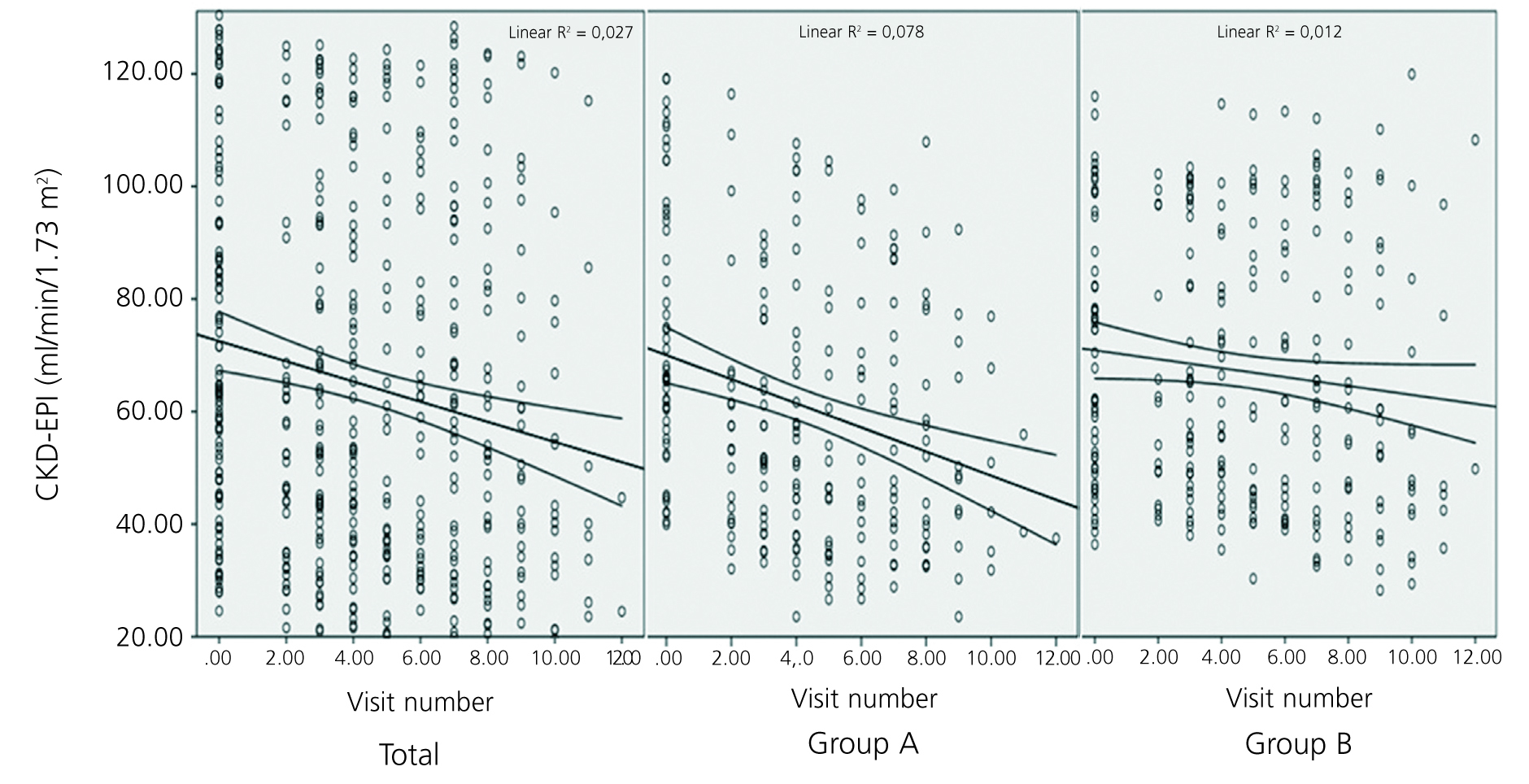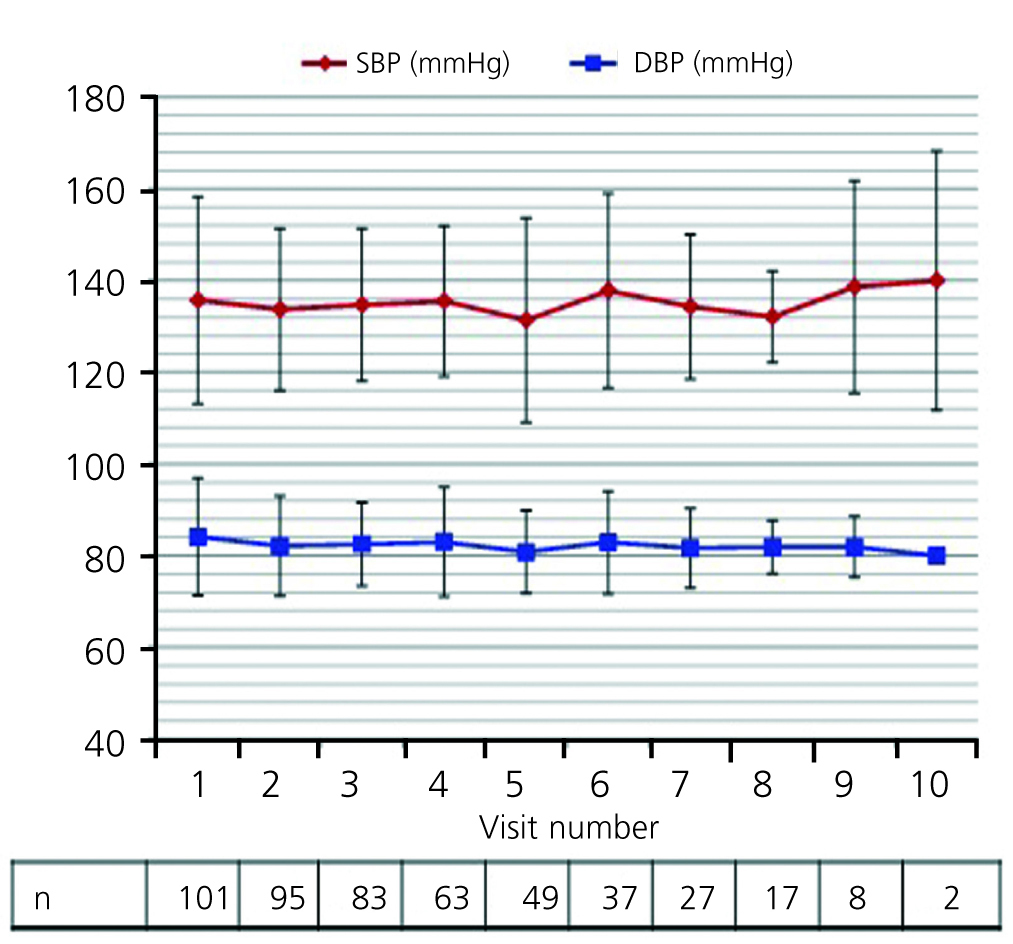Objetivos: El objetivo del presente estudio es analizar los factores que influyen en la progresión de la insuficiencia renal crónica en pacientes con enfermedad poliquística autosómica dominante (PQRAD). Material y métodos: Estudiamos a 101 pacientes (edad media: 43,6 ± 17,3, 43,6% varones). La mediana (rango intercuartílico) de seguimiento es de 69 (128-35) meses desde 1997 hasta 2010. Analizamos la progresión de dos formas: 1) tiempo hasta evento renal definido como la reducción del filtrado glomerular estimado (FGe) en un 50% desde la primera visita y/o entrada en diálisis, y 2) cambio medio en el FGe/año. Se recogieron en cada visita datos clínicos y demográficos, presión arterial sistólica (PAS) y diastólica (PAD), medicación concomitante y parámetros analíticos. También se recogió el tamaño renal basal medido por ecografía. Resultados: Treinta y un pacientes tuvieron un evento renal. La mediana de tiempo hasta la aparición del evento es de 102 (131-53) meses. Los pacientes que tuvieron un evento renal tenían basalmente mayor PAS y PAD (p = 0,017 y p = 0,001, respectivamente), mayores niveles de acido úrico (p = 0,041), mayor colesterol LDL (p = 0,001), mayor proteinuria (p = 0,033) y mayor tamaño renal (p = 0,05). El cambio medio de FGe/anual fue de –3,52 ± 7,3 ml/min/1,73 m2, 49 pacientes presentaron un descenso rápido de función renal: Grupo A (> –3,52 ml/min/1,73 m2) y 52 pacientes tuvieron una progresión lenta de la insuficiencia renal: Grupo B (< –3,2 ml/min/1,73 m2). Por regresión de Cox, en un modelo ajustado, la PAS y la menor edad al diagnóstico son las variables que mantienen su poder predictivo de mal pronóstico renal (p = 0,026). Conclusiones: La función renal inicial, proteinuria, tamaño renal, hipercolesterolemia, hiperuricemia y PAS basal son factores que influyen en la progresión de la insuficiencia renal en la PQRAD, siendo la PAS y la menor edad los factores que mantienen su poder predictivo independiente en el análisis multivariante.
Objectives: The aim of this study was to analyse the factors influencing chronic kidney disease (CKD) progression in patients with autosomal dominant polycystic kidney disease (ADPKD). Material and Method: We studied 101 patients (mean age: 43±17.3 years, 43.56% male) followed during a median (interquartile range) follow-up time of 69 (35-128) months from 1997 to 2010. The primary end point was: time to a 50% decrease of estimated glomerular filtration rate (eGFR) (CKD-EPI) since the first-time visit and/or time to initiation of renal replacement therapy, and the annual mean change of eGFR was also analysed. Clinical and demographic data, blood pressure, concomitant medications, and analytical parameters were collected at each visit. Baseline kidney size was also recorded by ultrasound. Results: Thirty-one patients achieved the primary end point after a median (IQR) time of 102 (53-131) months. Those patients who achieved the primary end point had higher SBP and DBP (P=0.017 and P=0.001), higher LDL-cholesterol (P=0.011), higher creatinine (P=0.006), higher uricemia (P=0.041), more severe proteinuria (P=0.033) and greater kidney size (P=0.05). The mean annual eGFR change was of –3.52±7.3ml/min/1.73m2. Forty-nine patients had a rapid decline in renal function: Group A (higher than -3.52ml/min/1.73m2) and 52 patients had a lower renal disease progression: Group B (<–3.2 ml/min/1.73 m2). Adjusted Cox regression analysis showed that higher SBP and younger age at the first visit were independent variables for poorer renal outcome (P=0.026). Conclusions: Initial kidney function, proteinuria, renal size, hypercholesterolemia, hyperuricemia, and SBP are the factors that influence CKD progression in ADPKD. SBP and younger age at diagnosis are the only factors that maintain their independent predictive value in a multivariant analysis.
INTRODUCTION
Autosomal dominant polycystic kidney disease (ADPKD) is one of the most common hereditary diseases observed and the most frequent genetic cause of chronic kidney disease (CKD).1-3 This disease affects one out of every 800-1000 people in the global population, and constitutes the aetiology for terminal chronic kidney disease (TCKD) in 5%-10% of patients on extra-renal purification programmes.4
Despite the importance of this health issue, it was not been the subject of much research until recent years, when several studies were performed with the objective of identifying predictive factors for a rapid progression of renal disease.5-7 Some of these factors can be modified by using different therapeutic interventions that are currently under study, such as tolvaptan,8,9 m-TOR (mammalian target of rapamycin) inhibitors,10 somatostatin analogues,11 and even rosiglitazone,12 which have been used successfully in animal models.
Among the factors that have been identified in the progression of ADPKD, the most important one is hypertension,8,14 but other possible factors for the progression of disease have been identified, such as African American race,15 male sex, haematuria, proteinuria, renal cyst volume, and polycystin 1 (PKD1) vs polycystin 2 (PKD2) mutations.1
The objective of our study was to perform a retrospective analysis of the factors that influence the progression of chronic renal failure in incident patients with ADPKD treated at our department throughout the last 13 years.
Our study, which dealt with patients at a single centre and thus a small sample size, stands out for the long follow-up period that, although was retrospective in nature, has been surpassed by only a few studies published to date. In contrast to other studies, the importance of systolic (SBP) as opposed to diastolic (DBP) blood pressure stands out as a factor for the progression of renal failure in these patients. Additionally, we have underlined the prognostic importance of age at diagnosis as a possible variable suggestive of which type of genetic mutation is present. As such, our study provides a simple and practical focus for the evaluation of the risk of rapid progression towards TCKD. We have also evaluated the role of other factors of progression such as dyslipidemia and hyperuricemia, which have been poorly studied until now.
MATERIAL AND METHOD
We included a total of 101 patients that were monitored at our clinic from 1997 to the present. Patients had been diagnosed with ADPKD based on standardised radiological criteria.16 Patients with ADPKD with less than two visits to our practice were excluded, whether because the patient abandoned the follow-up protocol or when a renal event occurred within the first year after diagnosis.
At each visit, we collected demographical variables, SBP and DBP values, concomitant medications, haemoglobin, creatinine (Cr), uric acid, total cholesterol, HDL-cholesterol, LDL-cholesterol, triglycerides, calcium, phosphorous, parathyroid hormone (PTH), proteinuria, and haematuria. Biochemical variables were measured using standard methods. PTH was measured using IRMA (intact 10-60pg/ml molecule, Allegro Nichols). Albuminuria was measured in 24-hour urine samples using immunonephelometric methods. Haematuria was defined in urine sediments as the presence of more than three red blood cells per microscopic field in at least two of three correctly collected samples.17 Kidney size (cm) was measured using renal ultrasound. Although each patient underwent several ultrasounds throughout the follow-up period, only baseline values were taken into account for the analysis, both for the largest renal cyst and maximum kidney diameter in centimetres. Since this was a retrospective analysis, we did not have an initially standardised methodology for taking measurements, and multiple professionals performed the procedures. Over the 13 years of the study, different radiologists evaluated the ultrasounds (three different doctors evaluated the majority of images). Inter and intra-observer variability was not taken into account.
Blood pressure (BP) was measured using an automatic sphygmanometer in accordance with the recommendations of the Spanish Society of Hypertension.18 Patients were considered hypertensive when SBP and DBP were equal to or greater than 140mm Hg and 90mm Hg, respectively, or if they were receiving anti-hypertensive drugs. The treatment objective was set at 130/80mm Hg, in accordance with the recommendations of the seventh report of the JNC (Joint National Committee on Prevention, Detection, Evaluation, and Treatment of High Blood Pressure).19
Dyslipidemia was defined as total cholesterol greater than 200mg/dl and LDL-cholesterol greater than 130mg/dl, in accordance with the European guidelines for cardiovascular prevention,20 or if the patient was receiving lipid lowering treatment.
Renal function was evaluated as estimated glomerular filtration rate (eGFR) using the CKD-EPI formula.21
We analysed the progression renal failure using the following two methods:
1) Based on the appearance of a renal event, defined as a 50% reduction in eGFR as measured by CKD-EPI from the initial values from the outpatient visit and/or entrance to dialysis.
2) Based on mean change in eGFR/year. According to the decrease in eGFR/year above or below the mean, we defined two different groups: group A: patients with a fast progression of CKD; and group B: patients with a normal progression of CKD.
Patients diagnosed with ADPKD were included in the study from the moment of their first visit with a nephrologist, considering all measurements from this consultation as baseline values, until a renal event occurred. Data were compiled on an annual basis, with the number of visits ranging between 1 and 10. The longest follow-up period lasted 13 years. The median follow-up time was 69 (35-128) months.
Values are expressed as mean ± SD (standard deviation) or median (interquartile range) if the variables did not follow a normal distribution. We used the Kolmogorov-Smirnov test to evaluate normal distribution for the different parameters assessed. For the analysis of differences between patients that suffered a renal event and those that did not, we used chi-square tests for qualitative variables and Student’s t-tests or Mann-Whitney U-tests for quantitative variables with a normal distribution or non-Gaussian distribution, respectively. We assumed that a difference was statistically significant when P<.05.
We performed a multivariate linear regression analysis using the variables that influenced annual change in eGFR. The prognostic value of the predictive factors for the appearance of renal events or rapid progression towards CKD was evaluated using a Cox regression multivariate model. We introduced all covariates into the multivariate model that had a predictive power for renal events or rapid progression in the univariate model with a P<.01. The regression coefficients and their SD were calculated using SPSS software, version 16.0 (Chicago, IL).
RESULTS
Our study included a total of 101 patients, 44 of which were male and 57 of which were female. The mean age was 43.5±17.2 years. The baseline characteristics for these patients are collected in Tables 1 and 2.
Figure 1 displays the evolution of eGFR (ml/min/1.73m2) in all patients and in the two different groups of disease progression.
Figure 2 displays the evolution of SBP and DBP values throughout the follow-up period. A total of 41.4% of patients were already receiving antihypertensive treatment with angiotensin-converting enzyme (ACE) inhibitors or angiotensin receptor blockers (ARB) at the start of the follow-up period. Throughout the study period, 16.9% of patients started treatment with ACE inhibitors and 15.7% with ARB, such that 74% of patients received antihypertensive treatment over the course of the study.
During the study period, 31 patients suffered a renal event. The median time of follow-up between the baseline visit and the event was 102 months (range: 53-131 months). The univariate analysis showed that patients that suffered a renal event had higher baseline SBP, DBP, uric acid, total cholesterol, LDL-cholesterol, baseline Cr, proteinuria, and larger kidney size (Table 3). There were significant differences in mean initial eGFR between the two groups, with 82.5±34.2ml/min/1.73m2 in the group of patients that did not suffer a renal event, and 59.8±22.7ml/min/1.73m2 in the group that did (P=.01). We observed no significant differences between groups for variables such as haematocrit, calcium, phosphorous, HDL-cholesterol, and triglycerides (results not shown in the table).
In the Cox regression model adjusted for baseline renal function, proteinuria, uric acid, BP, and cholesterol, SBP was the variable that maintained its predictive value for a renal event.
The mean annual change in GFR in the overall group of patients was -3.52±7.3ml/min/1.73m2. In the multivariate linear regression model, change in GFR was independently correlated with SBP (β=-6.7x10-2, P=.03).
We identified 49 patients with rapid disease progression (decrease >3.52ml/min/1.73m2): group A, and 52 patients with normal progression (less than 3.52ml/min/1.73m2): group B. There were no significant differences between the two groups in terms of initial eGFR, which was 74.1±32.7ml/min/1.73m2 in the group with normal progression, and 76.7±32.6ml/min/1.73m2 in the rapid progression group (P>.05). Group A patients had higher baseline SBP and proteinuria (Table 4). The logistic regression analysis revealed that the predictive variable for a rapid disease progression was still SBP, with the addition of a younger age at the first consultation, regardless of proteinuria, sex, initial renal function, and DBP (Table 5).
DISCUSSION
The primary result of our study, with a cohort of stable patients diagnosed with ADPKD and evaluated in nephrological consultations, was the confirmation that systolic arterial hypertension and a younger age at diagnosis are the most important factors that influence the long-term progression of renal failure.
Many recent studies on ADPKD have focused on the importance of renal volume as a determining factor in the deterioration of renal function, which advances parallel to the increase in cyst sizes.22 There are also other studies that correlate clinical and biochemical parameters with kidney size and glomerular filtration rate.5 However, there are few examples in the literature that correlate a patient’s baseline clinical characteristics with long-term clinical evolution as our study has. Recently, a retrospective cohort study was published with a follow-up period of 22 years, including 194 patients with ADPKD, which analysed the influence of mutation type on clinical characteristics and the development of renal events.23 Cyst growth appears to be one of the most important factors in determining the progression of CKD in these patients. As such, in many clinical trials focusing on therapeutic interventions, cyst growth has been used as the reference marker for identifying patients that could benefit from treatment.5,24 However, one of the most reliable methods for measuring renal structure and volume, standard magnetic resonance,25 is an expensive method that is not available in all hospitals and requires a large amount of time from the radiologist. A similar pattern occurs in computed tomography, which has been employed in volumetric measurements, with good correlation with total renal volume, renal cyst volume, and decrease in eGFR.26,27 Some authors have indicated that the deterioration in renal function does not depend on cyst volume as much as on the amount of intermediate tissue in polycystic kidneys measured by computed tomography.28 Other methods of measurement such as ultrasound do not provide as good a correlation for renal function,27 and so we need other variables from our clinical practice that aid in identifying patients that would benefit from early treatment. In our study, we evaluated kidney size using ultrasound, which was an imprecise method, taking into account that the measurements were taken by various radiologists. Although the univariate analysis revealed a difference in kidney size between patients that had a renal event and those that did not, this variable did not retain its predictive value when other parameters were adjusted for.
As such, in routine clinical practice, it would be very beneficial to have access to markers, aside from cyst growth, that would identify patients who, starting at an early age, will suffer a rapid progression in their kidney disease, and as such will be candidates for more aggressive therapeutic options, when sufficient evidence exists in the literature to support their use.
Arterial hypertension is a common clinical manifestation in patients with ADPKD. A recent demographic study performed in Turkey with 1139 patients with ADPKD identified this as the most common clinical manifestation in these patients, as it was present in 76% of cases.29 It commonly occurs early on, before the appearance of deteriorated renal function in 60% of cases.30 Several studies have related hypertension with the speed of progression in renal disease. One retrospective study with 94 patients compared rapid progression with slow progression patients, finding that those who progressed faster had a higher incidence of hypertension, haematuria, proteinuria, and urinary infections.31 Another study points out that hypertensive patients with ADPKD have worse renal function than normotensive patients, with an added increase in cardiovascular risk.32 There have also been studies showing a lower mortality rate33 and a progressive delay in the age at which these patients reach TCKD, relating this to a progressively better control of blood pressure levels in recent years,1,34 especially from the use of ACE inhibitors and ARB, although no differences have been found between the two drugs in controlling BP and Cr values in these patients.35 In a recently published study in Spain, kidney size was correlated with a pathological profile involving BP as measured in outpatient monitoring programmes, highlighting a greater variability in BP, especially diastolic, and lower pulse pressure with greater kidney size, as measured using ultrasound, even in a stage of pre-hypertension.36 Our study corroborated these findings, with the novel result that it is SBP, not DBP, that maintains its independent predictive value for the rapid progression of kidney disease, which is in agreement with the results from other studies, such as the report by Cadnapaphornchai et al.,37 which analysed the association between renal volume, SBP and DBP, and left ventricular mass index in patients with ADPKD. As in our case, they detected an association between both BP variables and renal volume in the univariate analysis, but only SBP remained after adjusting for age and sex in the multivariate analysis.
The percentage of patients that were already receiving treatment with renin-angiotensin-aldosterone system (RAAS) blockers at the start of treatment was 41.4%; 32.6% started treatment with these drugs during the follow-up period. In total, 74% received treatment with RAAS blockers over the study period. We observed no differences between patients receiving this treatment and those that did not, whether in terms of the appearance of renal events or the speed of progression. However, it is well known that control of BP levels, especially systolic, is a fundamental factor for slowing the progression of kidney disease, not only in ADPKD, but in CKD in general, as demonstrated by several studies.38-40 In the specific case of ADPKD, the HALT study is currently under way, with the goal of elucidating the potential benefit of strict BP control using RAAS blockers in slowing the progression of TCKD.41
In the univariate analysis, we found that patients with a renal event or rapid disease progression had higher initial proteinuria values than those with a slow disease progression/absence of renal events. However, this variable did not maintain its predictive value in the Cox regression analysis, despite the fact that proteinuria is a known factor for the progression of kidney disease.42 This fact was probably due to the low values of proteinuria displayed by our patients (median: 19.75; IQR: 0-58.5), as proteinuria is an uncharacteristic manifestation of this disease.
Our second notable finding was that younger patients had a higher rate of decrease in eGFR. These results concur with those from Torres et al., who showed that a younger age at diagnosis is associated with a greater increase in total renal volume, and this, in turn, is correlated with a greater rate of decrease in glomerular filtration rate.5 Although we did not perform a genetic study, we can put this finding in the context of the higher probability that these patients have a mutation on the PKD1 gene, which tends to produce a greater pathological repercussion and earlier deterioration in renal function.43,44 These results are supported by those from the genetic study by Torra et al., which found that, in patients with ADPKD that had not reached TCKD by the age of 63 years, the prevalence of PKD2 mutations was three times higher than the estimated proportion for the general population with ADPKD.45 Other studies also coincide on the finding that, in families diagnosed with the disease in which at least one member reached TCKD at an age younger than 55, there is a high probability that the mutation is on the PKD1 gene.46
Our results also demonstrate the importance of controlling other cardiovascular risk factors, such as cholesterol and uric acid, both for the progression of CKD in patients with ADPKD and in other renal pathologies. Although these parameters do not independently influence the progression of renal failure, they do appear to be important and controllable variables in the appearance of renal events in the univariate analysis. Several studies have suggested that ADPKD produces an increase in uric acid levels associated with decreased renal function,47 but there are no data regarding the influence of uric acid levels on the progression of the kidney disease in this particular case. However, in recent years, the relationship between hyperuricemia and the progression of CKD has been investigated,48,49 and recently the use of uric acid lowering drugs (allopurinol) has been shown to reduce disease progression.50 As regards lipid control, several studies have indicated that lower HDL-cholesterol levels are correlated with increased deterioration of renal function,5 although we have not found data in the literature that show the influence of LDL-cholesterol levels on renal function in patients with ADPKD. Even so, the fact that patients with worse cholesterol levels have more renal events supports the hypothesis held by some trials that have attempted to show that renal function in these patients could be improved by using statins, through an increase in renal plasma flow derived from improved endothelial function.51
Our study is not without its limitations. The primary limitation in our case was that, while the study design was a prospective, longitudinal type, the data collection was retrospective, with the inherent drawbacks from the point of view of data analysis, and so we can only show evidence of an association between systolic hypertension and increased disease progression. Additionally, the sample was not sufficiently large due to the fact that our data were derived from one single centre. However, despite the small sample size, the extremely long follow-up period has been surpassed by only a few isolated studies available in the medical literature,1,33,34 which bolsters the validity of our results. We should also point out the limitations of the absence of a genetic analysis, along with the use of renal ultrasound instead of a computed tomography or nuclear magnetic resonance for the evaluation of initial renal volume.
We can conclude that a younger age at diagnosis and higher SBP values are the two factors associated with a greater progression of renal disease in our patients with ADPKD. These two variables, which are easily measured, allow us to detect patients that have a high probability of a faster progression towards TCKD in centres that do not have easy access to genetic analyses or magnetic resonance. This in turn provides the possibility of selecting these patients as candidates for possible future treatments that show long-term advantages in slowing the progression towards the need for extra-renal purification. Interventional studies are needed to establish the potential benefit of controlling SBP values, cholesterol, and uric acid in slowing the progression towards TCKD in these patients.
Conflicts of Interest
The authors have no potential conflicts of interest related to the content of this article to declare.
Table 1. Baseline patient characteristics (qualitative variables)
Table 2. Baseline patient characteristics (quantitative variables)
Table 3. Predictive factors for renal events. Univariate analysis
Table 4. Predictive factors for a rapid progression in kidney disease. Univariate analysis (Students t-test)
Table 5. Predictive variables for a rapid progression in kidney disease. Logistic regression
Figure 1. Decrease in glomerular filtration rate in all patients and in the two different groups of disease progression
Figure 2. Evolution over time of SBP and DBP values during follow-up. Mean (SD)




















